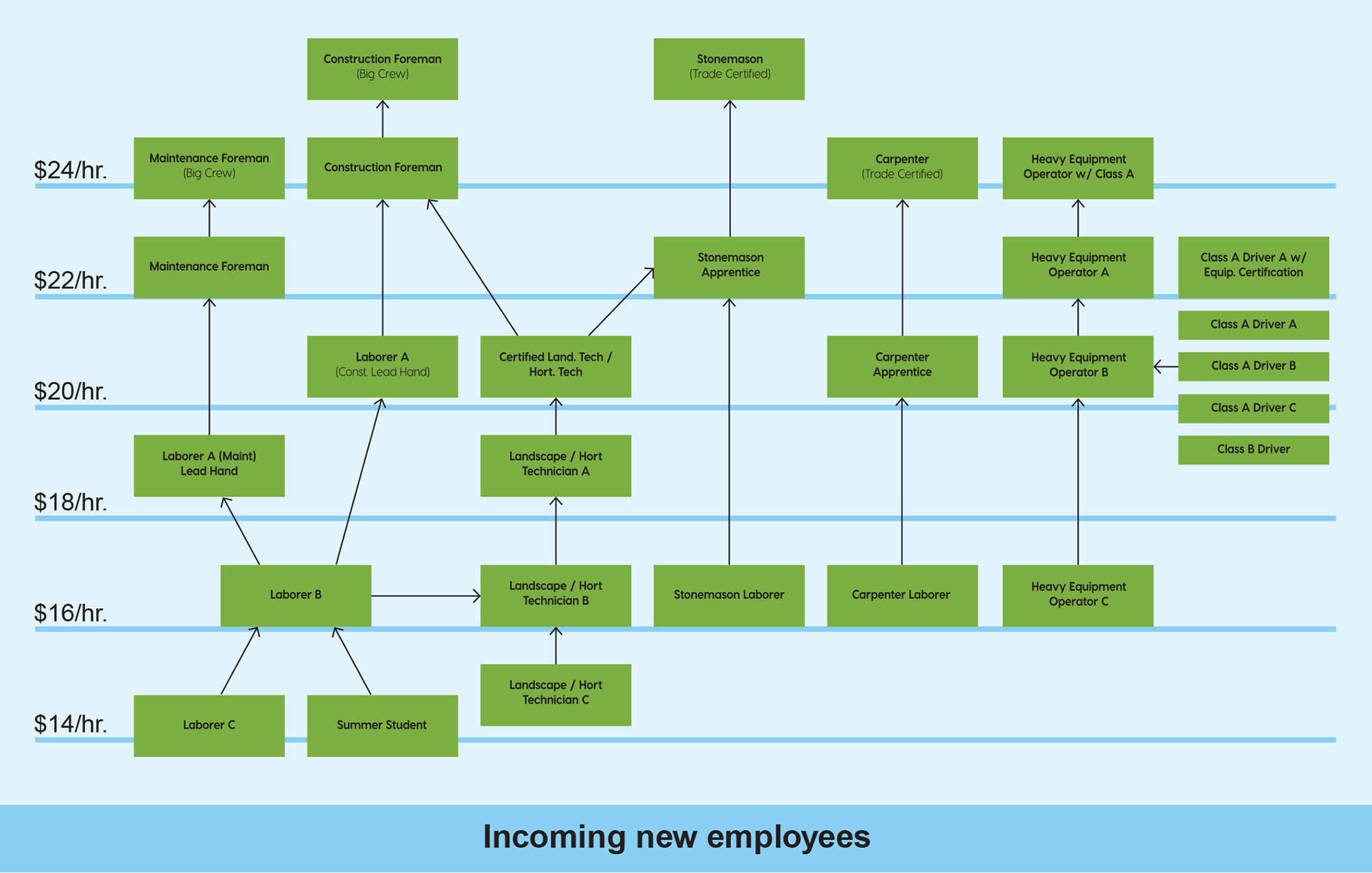October 4, 2018

Looking for motivated staff? Define opportunities
BY MARK BRADLEY Now, more than ever, attracting and keeping good people is the #1 problem for landscape owners. Work is everywhere, but there are just not enough experienced, skilled people to meet the demand. It’s more important than ever to break your traditional hiring cycle, and build a company that creates opportunities.
Now, more than ever, attracting and keeping good people is the #1 problem for landscape owners. Work is everywhere, but there are just not enough experienced, skilled people to meet the demand. It’s more important than ever to break your traditional hiring cycle, and build a company that creates opportunities. The problem
Our industry faces significant labour challenges. Our average wages are lower than other trades. We don’t attract enough good, young talent out of schools. Most companies are small businesses working without a plan, with no clearly articulated opportunities for advancement, and no formalized training. Many can guarantee steady pay for only eight months of the year. Turnover is high. The work is hot, cold, wet, and dirty — sometimes all at once. No wonder it’s hard to find people who want to commit their futures to our industry.Most companies lie down and play victim to labour problems, but every company has a choice. A select few seize this opportunity to differentiate, and improve themselves. The “labour problem” can be an extremely powerful competitive advantage, if you can turn an industry weakness into one of your company’s greatest strengths.
“If opportunity doesn’t knock, build a door.”
— Milton Berle
Build a door of opportunity
During performance reviews at our own company, it became obvious we lacked a system for employees to envision how they fit in. We commented on things they did well, and things they needed to improve. Then came questions we did not have good answers for: “When will I be re-evaluated? What can I do to get to the next level? What kind of pay range does this position make? Where can I get training?” There was motivation to improve, but we had no structure in place, so that motivation quickly turned into frustration.We set to work to create a career ladder system that defined opportunities and the criteria required to move up the ladder. There were five main steps to implementing the system.
STEP ONE: Define the roles. Identify positions within your company as an opportunity tree. Even if you had no formal positions before, draw out what they would look like. If they are not clear to you, imagine how your staff feels about opportunities with your company. Make it look like a flow chart or an org chart — something people can visualize. Use it for new and current hires to illustrate opportunities available to them.
STEP TWO: Define responsibilities for each role. Clearly spell out the responsibilities owned by each role or employment level. Level B labourers must have these skills/training in place, Level A laborers require these additional skills. Put the company’s expectations in writing, to give staff a clear roadmap to success. This will serve your staff and your company well. If there is a cost to some of the training, ensure you articulate how training expenses will be covered. For example, you might pay for the course, but not the time spent. Specify circumstances, such as successful completion of the course.
STEP THREE: Set a pay grade for each role. Set fixed wage floors and ceilings for each role. Ceilings motivate employee development better than seniority. An A-Level labourer should eventually hit a wage ceiling. In order to earn a raise, it will be clear they must develop the skills necessary for the next role up the ladder. This is far more effective than raises based on tenure or, even worse, based on an ultimatum.
STEP FOUR: Align your goals. I believe strongly in employee incentives, especially at the foreman level. Hourly wages are necessary, but if we really want to inspire performance, we must create incentive systems that reward staff for achieving company goals. Keep your goals objective. Bonuses given without transparent calculations are forgotten faster than they are spent. Objective goals are based on criteria such as beating sales or production targets, beating estimated hours or beating a target Sales-to-Wages ratio (total sales divided by total wages).
STEP FIVE: Stick to it. You need regular feedback and reinforcement. Schedule performance reviews at least once a year with written objectives, and give your staff a copy. Review wages only during scheduled performance reviews, which helps stop spontaneous raise requests! Share information, like how the company is doing relative to bonus or incentive goals. Discuss it in meetings. Put a chart on the wall at the shop. Without regular reinforcement, this will be just another change that didn’t work.
 Use an opportunity tree chart to help staff visualize paths to grow in their careers, and how taking on more responsibility will affect their wages. The wages and positions in this sample are meant to illustrate, not as a model.
Use an opportunity tree chart to help staff visualize paths to grow in their careers, and how taking on more responsibility will affect their wages. The wages and positions in this sample are meant to illustrate, not as a model.
The results
Better hiring. Your opportunity tree diagram is a great tool when you’re hiring! Pull it out and show prospects the opportunities for growth in your company. You will excite the right kinds of employees, and drive the wrong kinds to find work at less serious companies.Better motivation. Without an opportunity system, staff will lack drive and motivation. Visible opportunities, clear criteria, incentive systems and wage ceilings work together to provide strong incentives for improvement.
Better culture. Raises and promotions are earned on objective criteria, not subjective feelings. Expectations and results are clear.
Better accountability. You’re putting responsibility on your employees to develop themselves. You have provided the framework, and it’s up to your staff to take advantage of it.
Better responsibility. Delegate work more easily by making certain roles and responsibilities part of your opportunity criteria. Inspire others to sweat the small stuff, so you can focus on the big picture.
Better profit. Worried about higher costs due to raises? Consider this: A raise of $1 per hour costs about $12 a day after taxes, etc. If that employee is 10 per cent more productive as a result of their training, your culture, their experience and attitude, they’ll add between $40 and $100 more revenue each day. That’s a great return on your $12 investment.
Defining opportunities for your staff is not just an investment in your people, it’s an investment in a sustainable and consistently profitable business for you. Hiring for key positions off the street is like handing the keys to your business to a stranger. It’s how so many businesses get stuck making the same mistakes and having the same problems all over again. It’s why so many owners have difficulty pulling themselves out of day-to-day operations.
If you want better, more motivated staff, give them something to get motivated about. Hourly wages and random raises won’t cut it for this generation. Show your staff the opportunities available to them. Help them take on more responsibilities and more important roles. Build better staff, a better company, and turn an industry weakness into a competitive advantage — all at once.
Mark Bradley is president of Ontario-based TBG Landscape and the Landscape Management Network (LMN).